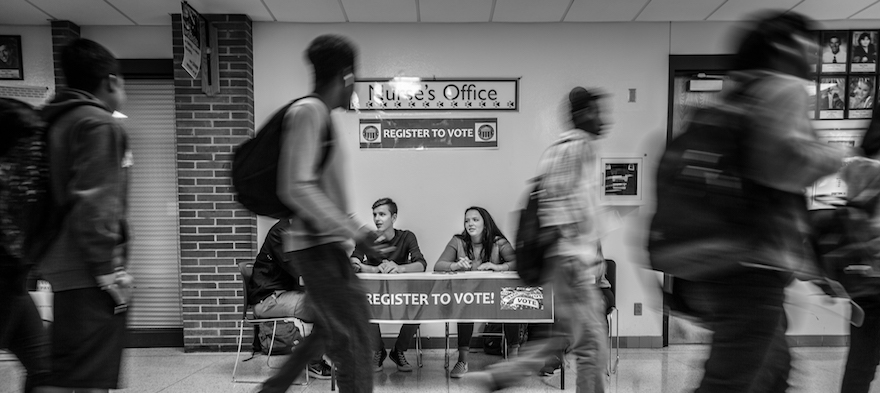Government is not a static entity to be studied. It is a living, breathing being, which young people can learn to understand and influence. Never has it been more important for our youth to grasp this idea than right now. Since 1968, when
voter turnout reached a high-water mark of 64 percent, participation has dropped. It sank to just below 52 percent in 1996 and has yet to return to 1968 levels, even in the highly charged elections of 2008 and 2016. Despite the political acrimony now rampant in this country, [pullquote position="right"]all concerned can support the need for more turnout from eligible voters.[/pullquote] This creates a perfect, risk-free opportunity for students to engage with the political process. To encourage turnout, my middle school students produced public service announcements (PSAs) about the importance of voting. When I contacted local station managers to test their enthusiasm for helping students create and produce these messages, the response was 100 percent positive. Many wanted community-created PSAs instead of the usual boring products developed by the Federal Communications Commission.
[sc_embed_player fileurl="https://educationpost.org/wp-content/uploads/2018/10/02-Track-2.mp3"] Click arrow to listen to PSA
Station managers loaned their advertising people to my students to help them write effective copy and connected them with producers. We worked together for two weeks to produce scripts, rehearse and create the final product. We built PSAs around themes like low voter turnout, civic responsibility and voting as the foundation of a democratic republic. The ads ran on local media starting four weeks before Election Day. They attracted plenty of attention. Students were interviewed by the radio stations and became a local TV news story. The school found itself in a positive light, putting huge smiles on my bosses. Most important, my students enjoyed the glow of the spotlight for doing something important for their community. Election Day came and went. Voter turnout for the community exceeded expectations. [pullquote]Almost 70 percent of registered voters took part, up from a previous low of just 40 percent.[/pullquote] Whether or not there was a direct correlation between my students getting involved and the high participation level is unclear. But what is clear is my students got a taste of civic participation, the school was viewed in a positive light by the community, and they developed their creative skills: writing, acting and problem solving.
When We Make Space for Students to Create, the Results Are Amazing
Similar skills were on display in February of 2018 after the school shooting at Marjory Stoneman Douglas High School in Parkland, Florida. After the shooting, the Parkland students spoke out against current Florida gun laws and staged a “March for Our Lives.” Some political commentators claimed these students were crisis actors because they were so articulate and focused in their message delivery. These detractors did not realize many of the students were involved with competitive debate. They were trained to develop solid arguments about complex issues and present their views in a compelling and persuasive manner. Their ability to persuade grabbed the nation’s attention and sparked a national discussion about gun policy and school violence which is still burning. Former House Speaker Tip O’Neill is credited with the phrase, “All politics is local.” Schools need to provide an environment where the learning is not rote or aimed at standardized test performance but aimed at the social and emotional learning of their population. When students are provided with the opportunity to create and deliver their message, the results are amazing and the learning is lifelong and deep.
